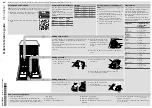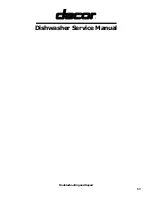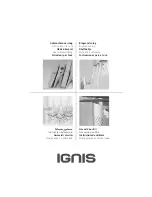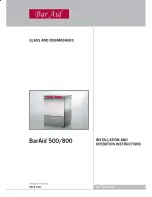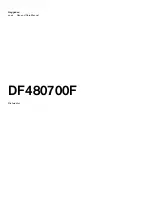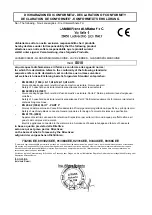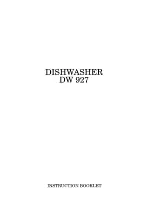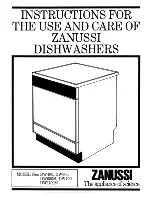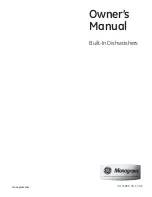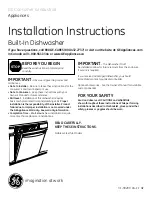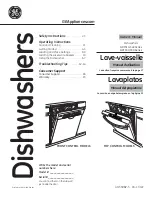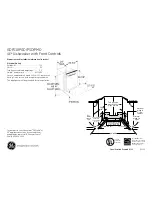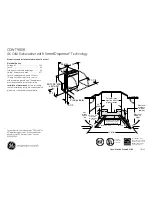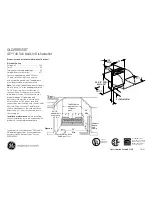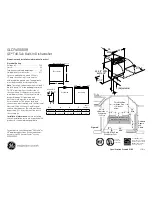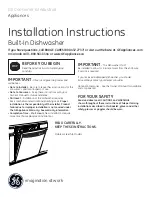
13
Dishware Stained or Discolored
• Tea and coffee can stain cups. Remove the stains by
hand washing in a solution of 1/2 cup (120 ml) bleach
and one quart (1 L) of warm water. Rinse thoroughly.
• Iron deposits in water can cause a yellow or brown
film. A special filter installed in the water supply line
will correct this problem. (See Removing Spots and
Film.)
• Aluminum utensils can leave gray/black marks when
they rub against other items. Load properly.
• Certain high acid foods can cause discoloration of
stainless steel and plastics if allowed to sit for a long
period. Use the Rinse Only cycle or rinse by hand if
not operating dishwasher at once.
• Mixing stainless steel and silver utensils in silverware
basket can cause pitting of the stainless steel blades.
Avoid mixing stainless steel and silver.
Etching
• Using too much detergent in soft or softened water
causes this film that cannot be removed.
• Adjust the amount of detergent based on the water
hardness. (Check Detergent Chart.)
• Lower the water temperature.
• Use no heat dry option.
Detergent Left in Cups
• Detergent may be old. Discard and use fresh
detergent.
used for cycle selected. Also, check phosphate level.
(See Detergent Dispenser.)
• Home water pressure may be too low—it should be
20 to 120 pounds per square inch (psi).
Dishware Chipped
• Load with care and do not overload. (See Preparing
and Loading Dishes.)
• Place delicate items in top rack.
• Place glasses securely against pins and not over pins.
• Load items so they are secure and don’t jar loose
when moving racks in and out. Move racks in and out
slowly.
• Make sure tall glasses and stemware will clear top of
tub when rack is pushed in.
• Fine antique china and crystal should be hand-
washed.
Before calling for service, review this list. It
may save you both time and expense. This list
includes common experiences that are not the
result of defective workmanship or material in
your dishwasher.
Food Soils Left on Dishes
• Choose another cycle for longer washing time.
• Check rack loading section for proper loading—avoid
nesting items.
• Home water pressure may be too low—should be 20 to
120 pounds per square inch (psi).
• Check incoming water temperature. It should be at least
120°F (49°C). (See Factors Affecting Performance.)
• Check water hardness. For extremely hard water, it may
be necessary to install a water softener. (See Detergent
Chart.)
• Use fresh detergent.
• Check to make sure funnel in top rack is not blocked.
• Make sure items are not blocking the spray arms,
preventing them from rotating.
Dishes not Dry
• Select heat dry option.
• Make sure the rinse aid dispenser is filled.
• Increase the amount of rinse aid. (See Rinse Aid.)
• Check the incoming water temperature. Be sure it is at
least 120°F (49°C).
• Check for proper loading—avoid nesting items.
• Plastic items may need to be towel dried.
• Cups with a concave bottom will collect water.
Glassware/Flatware Spotted or
Cloudy
• Check water hardness. For extremely hard water, it may
be necessary to install a water softener. (See Detergent
Chart.)
• Water temperature may be low. Avoid extremely low or
high temperatures. (See Factors Affecting Performance.)
• Avoid overloading and improper loading. (See Preparing
and Loading Dishes.)
• Use fresh detergent. Old detergent is ineffective.
• Make sure rinse aid dispenser is filled.
• Check to see that proper amount of detergent is being
SOLUTIONS TO COMMON DISHWASHING PROBLEMS
Summary of Contents for 154811101
Page 16: ......

















